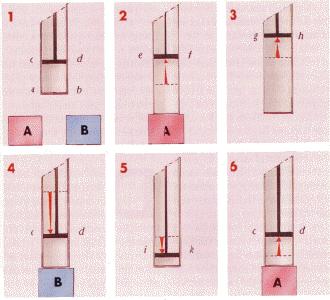Carnot Engine

- "Air at temperature T1 is held in a cyclinder, closed by an insulated piston (starting position: cd). A hot source A, with temperature T1, and a cold source B, with temperature T2, constitute infinite reservoirs of heat.
- The cylinder is put in contact with A: the heat passes from the source to the air, that relaxes freely and pushes the piston to the position ef.
- The cylinder is isolated from all source of heat. During its adiabatic expansion, the air pushes the piston until gh: its temperature falls to T2.
- The cylinder, with temperature T2 then, is put in contact with the heat source B, with identical temperature. A "theoretical" experimenter pushes the piston downwards: this isothermal compression brings it to position cd. Heat passes from the air to the source B.
- The cylinder is isolated from the outside again. The "theoretical" experimenter continues to push the piston until it reaches position ik, in such a way that the air temperature reaches T1.
- The cylinder is put in contact with A, which delivers heat to the air: it expands until the piston comes back to its initial position cd."
http://www.carnot.org/ENGLISH/carnot%20cycle.htm#Carnot%20Cycle